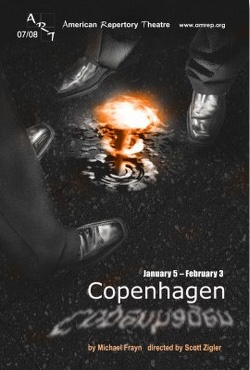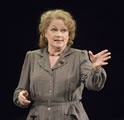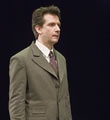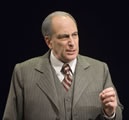Compelling Must See Copenhagen At the American Repertory Theatre in Cambridge
Playwright Michael Frayn's Wartime Imagined Emotive Meeting Between Atomic Energy Father Figure Niels Bohr and Nazi Atomic Scientist Werner Heisenberg.
By: Mark Favermann - Jan 22, 2008
COPENHAGEN
By Michael Frayn
Directed by Scott Zigler
January 5 - February 3, 2008
At the Loeb Drama Center
Tickets online or call 617.547.8300
The Cast: Niels Bohr/ Will LeBow. Margrethe Bohr/ Karen MacDonald. Werner Heisenberg/ John Kuntz.
The Crew: Set and costume design: David Reynoso
Lighting design: Kenneth Helvig
Sound design: David Remedios
Science versus morality, ethics versus professional achievement, the mystery of life versus the value of life and the concepts of all out war versus human mercy are all extremely heavy sets of competing philosophical and emotional balances. One situation that dramatized these excruciatingly difficult questions actually occurred in 1941 in the City of Copenhagen between one of the fathers of atomic energy, Niels Bohr, and a former star student and colleague, Werner Heisenberg. This rather short and somewhat mysterious wartime meeting is the starting point for playwright Michael Frayn's compelling, must see drama, Copenhagen.
Eventually, Bohr escaped from Denmark, made his way to the United States, and went on to assist with the Los Alamos research that resulted in the dropping of atomic bombs on Nagasaki and Hiroshima, Japan. Heisenberg failed to create a bomb for the Nazis. Add to this mix the fact that Bohr was partially Jewish, and Heisenberg was a German Aryan. So add theoretical physics with atomic bomb development to professional egos and factor in the Jewish Annihilation Question with Nazi Ideology countered by Allied democratic principles. Add to all of this the abstracted concept of Heisenberg's Uncertainty Principle.
The result is a heavy brew that must take into consideration ethical behavior during a time of all out war, moral quandaries of scientific goals, mass annihilation, personal friendship and professional courtesy and very human personality flaws. Like the greatest classic plays, there is absolutely no clear resolution in Frayn's Copenhagen. We are left with many questions and no real answers. Yet, this unresolved situation is not necessarily unsatisfying but actually quite edifying.
The American Repertory Theatre (ART) is known for its edgy and often wonderfully provocative theatrical productions. So it is extremely interesting that ART chose to produce Copenhagen. The drama has been around since the late 1990s and been performed on Broadway, around the world, on both the BBC and PBS television stations, as well as performed locally. It is considered a modern theatre classic. Yet, this ART version, with its interpretive reading, adds other nuances that were never suggested to me before: perhaps Heisenberg purposely muddled the development of the German bomb, and through his influence, allowed Bohr to escape from German-occupied Denmark to neutral Sweden and from there on to the US; or perhaps not?
We view this play from a strange and somewhat changing perspective. The characters are at once involved in a conversation and yet stand back from it to view what they said and analyze why they said it. They are in some sort of cosmic, almost heavenly, environment looking down and back while discussing what occurs both in real time and as remembered. Somehow, often brilliantly, we are not bothered by this. This is a major play of ideas and issues greater than our own individual lives and personalities. We are asked to think. And, it is the resultant thought process that makes this theatrical experience meaningful and great.
The play is actually in two acts but with three parts. The first act lays out the situation, the history of their friendship/mentor relationship and a twenty year history of developments in atomic physics. The second act analyzes the situation from two related perspectives: The human often very personal relationship, and the scientific, professional affiliation. The play could have actually ended after Act One, yet the playwright further develops all of the conflicting issues and strategic ideas in Act Two.
The actors and their portrayals are superb. An ensemble company like the American Repertory Theatre, with its great actors, artists and performers represents an amazing resource to be able to draw from for wonderful theatre. Longtime ART performers Will LeBow, and Karen MacDonald, never seem to let down their high quality work in whatever they are asked to play. John Kuntz, playing in his first major role for ART, is certainly up to their high standard.
In Copenhagen, LeBow portrays Bohr as a proud, thoughtful but rather unsettled academic scientist. He has gravitas. Yet, there is a twinkling of humanistic angst about his role as a father figure, a master teacher, a sensitive mentor and even as a friend. LeBow plays a weighty role. The actor seems weighted by his character's scientific mission and major ethical and personal conflicts. His wife, played by MacDonald, points out his human qualities as well as a few flaws often to LeBow's/ Bohr's chagrin as a husband and actual father as well. This is done while she also superbly supports him as the genius and great man that he was. Will LeBow's thoughtful performance interprets Bohr as a very human great man.
Karen MacDonald's performance as Margrethe Bohr is as good as it gets. She is at once the humanistic counterpoint to the overly scientific discourse between Bohr and Heisenberg. Her words keep the conversation grounded while the two scientists abstractly and often hyper-technically argue their points. She also is something of a Greek (Danish?) chorus to the quantum physics scenarios by adding homely additions about domestic events, moments and errands. Her characterization is the most fully developed by any of the actors. Her wonderful voice, exquisite timing. and effortless stage presence form her character's charm, intellect and even wit.
John Kuntz is also superb as the hard to read Werner Heisenberg. This character has layers to him that are not fully peeled away. Kuntz seems to express the real conflicts about who he was, what he wanted to become and what he was involved with doing inherent in the historical Heisenberg. These are further nuanced by what he presents as Heisenberg the individual person and unique personality. At times, Kuntz plays Heisenberg as an argumentative former graduate student; at other times, as the arrogant student who feels that he has surpassed his teacher. At still other moments over the course of the play, he plays the German uberscientist as a sort of the conflicted administrator/bureaucrat who tries to make his case, no matter what. He does it all with a consistent well crafted quality.
Above the stage was a visually arresting light sculpture that suggested the movement of an atom with the electrons and protons moving in elliptical orbits. This was set in contrast to the extremely bare stage with just three chairs arranged and rearranged by the actors. There was a mirrored wall at the back of the stage that at times reflected the very distorted images of the characters. Using the eerily spare but effective set, the designer, David Rynoso, was evocative without underscoring visually any sense of human warmth. Perhaps this was due to the subject matter. Perhaps, it was the playwright's focus and the director's interpretation.
This play is primarily about the struggle of cold science versus issues of humanity. Thus, throughout the visual sparseness and the minimalist environment, there is a lack of color (did I say that everything including the characters' clothing looked grey?) except in the play's argumentatively volatile and cataclysmic issues and descriptively eloquent words. The color is in the thoughts and expressions of the characters. The lighting design by Kenneth Helvig and the sound design David Remedios added elegance and atmosphere to the spareness and restraint of the theatrical environment.
Michael Frayn's Copenhagen is a thinking play. The actors have to think to emote their lines. The audience has to think to even attempt to understand all of the multiple aspects of the heavy issues involved. The intelligence of this ART production is clearly superb. To see this production is to experience theatre at its finest.





